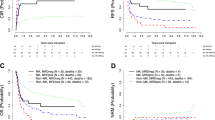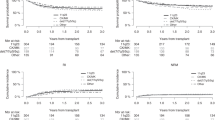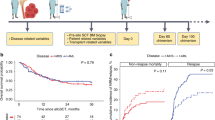Abstract
Cytogenetic analysis performed at diagnosis is widely recognised to provide one of the most valuable prognostic indicators in AML. Yet any role for this technique in residual disease assessment, particularly in the context of subsequent transplantation procedures has been incompletely explored. The present study considers the outcome of 190 patients drawn from the UK MRC AML 10 trial in whom cytogenetics were assessed whilst in morphological CR at the time of bone marrow harvest. Cytogenetics at this stage were abnormal in 19 patients (10%). In 11/19 patients, the abnormalities detected reflected the acquisition of new clonal (3/11) or non-clonal changes (8/11) that were not identified at diagnosis; comparison of this group to patients with normal cytogenetics at harvest provided no evidence that such acquired changes are of prognostic significance. In 8/19 patients, abnormalities detected were indicative of persistence of the disease-related clone in harvested marrow. Two of these patients died of sepsis during consolidation therapy. Two received ABMT in first morphological CR: one patient with AML associated with a favourable karyotype (+8,inv(16)) remains in CR, 5.5 years post-transplant, whereas the other with cytogenetic abnormalities considered to confer a poor prognosis (inv(3q),−7), relapsed within 5 months of ABMT. All four of the remaining patients with cytogenetic evidence of persistent disease who were not transplanted in first CR, relapsed within 6.5 months of harvest. Therefore, among 101 of 190 patients with AML characterised by abnormal karyotype at diagnosis, persistence of the disease-related clone in eight patients (8%), revealed by conventional cytogenetic assessment at bone marrow harvest whilst in morphological remission, was found to predict a poor prognosis. Nevertheless, transplantation procedures using marrow which is obviously contaminated with the original leukaemic clone may occasionally still be associated with long-term survival.
This is a preview of subscription content, access via your institution
Access options
Subscribe to this journal
Receive 12 print issues and online access
$259.00 per year
only $21.58 per issue
Buy this article
- Purchase on Springer Link
- Instant access to full article PDF
Prices may be subject to local taxes which are calculated during checkout
Similar content being viewed by others
Author information
Authors and Affiliations
Rights and permissions
About this article
Cite this article
Grimwade, D., Walker, H., Oliver, F. et al. What happens subsequently in AML when cytogenetic abnormalities persist at bone marrow harvest? Results of the 10th UK MRC AML Trial. Bone Marrow Transplant 19, 1117–1123 (1997). https://doi.org/10.1038/sj.bmt.1700804
Received:
Accepted:
Issue Date:
DOI: https://doi.org/10.1038/sj.bmt.1700804
Keywords
This article is cited by
-
Prognostic and therapeutic implications of measurable residual disease in acute myeloid leukemia
Journal of Hematology & Oncology (2021)
-
Minimal residual disease by either flow cytometry or cytogenetics prior to an allogeneic hematopoietic stem cell transplant is associated with poor outcome in acute myeloid leukemia
Blood Cancer Journal (2017)
-
Elevated levels of WT1 transcripts in bone marrow harvests are associated with a high relapse risk in patients autografted for acute myeloid leukaemia
Bone Marrow Transplantation (2005)



